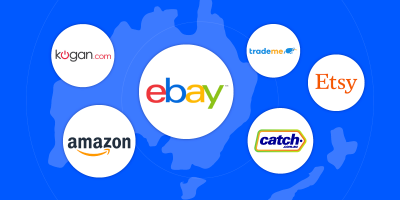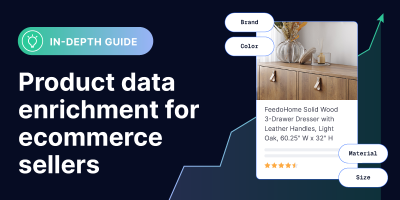Competitive ecommerce sellers always look for ways to keep their businesses on the cutting edge of industry-changing technology.
To help guide you through shifts in the ecommerce landscape, we’ve identified four major changes to look out for in 2024, along with insights and commentary from industry-leading professionals.
#1: AI will continue to drive operational changes
Last year, AI took center stage in tech. Google rolled out Google Merchant Center Next, and other channels—including marketplaces, social commerce platforms, and search engines—made announcements about AI tools for advertisers and sellers.
Sharon Gee, SVP of Sales and Partnerships at Feedonomics, sees the AI-in-ecommerce trend continuing into 2025.
“I think we’re blue in the face hearing about AI, but it’s because we’re at an inflection point that I can’t overstate,” Gee said during an episode of the BigCommerce Cab video series. “By this time next year, we will be seeing completely different experiences powered by amazing product catalog data—excellent, completely composable, personalized experiences—because the technology finally exists for us to deliver a seamless omnichannel experience no matter which touchpoint that is.”
Here are some other ways that ecommerce businesses will continue leveraging AI in 2024:
Customer support
You’ve undoubtedly come across or even used chatbots; they’ve become an increasingly common way of streamlining customer service.
Today’s chatbots can understand and respond to customer queries in real-time, offer personalized product recommendations, assist with order tracking, and resolve common issues with little to no human intervention. This reduces the workload on customer service teams and allows customers to receive instant support outside of business hours.
Personalization
An IBM report shows that of the businesses that used AI in 2022, 35% of them used it to create more personalized experiences. In 2023, some reports showed that number grew to as high as 92%.
AI can collect and analyze product and customer data to produce more personalized product recommendations and communication like emails and text messages.
Meghan Stabler, SVP of Marketing at BigCommerce, also thinks focusing on the customer’s unique preferences will be a winning strategy for brands in 2024.
“[2024 is] going to be intense, and I think a lot of it is going to be around personalization,” Stabler said during an episode of the BigCommerce Cab video series. “Customer-centricity, customer-first, customer-experience, hyper-personalization.”
Product categorization
Companies can use AI to more accurately categorize their products on marketplaces and ad channels. This improves the customer experience, helps merchants reach the right shoppers, and unlocks category-specific attributes in your product listings that provide consumers with important information.
As ecommerce becomes more competitive, companies will look to find tools that enable them to make the most of their existing assets.
For example, our FeedAi technology automatically categorizes products 17 times faster than manual categorization, with more than 96% accuracy. This technology works for any channel that accepts a Google product category, including Google Shopping, Facebook, Instagram, Microsoft Shopping, Pinterest, and Snapchat.
Generating copy and images
Generative AI tools like ChatGPT allow ecommerce brands to quickly generate placeholder content for their websites, product descriptions, and product titles. The content should be edited and optimized, but AI can get the ball rolling much faster for brands starting from scratch.
Other tools like Google Product Studio allow you to easily create product lifestyle images by generating new image backgrounds for your product.
#2: Instant commerce opportunities will increase as fulfillment networks and integrators grow
Instant commerce, also known as quick commerce, is a business model that provides rapid delivery and fulfillment of customer orders within hours—or even minutes—of them being placed. Benefits of this model include increased customer satisfaction, sales, and foot traffic.
Between 2021 and 2023, mobile searches that contained “near me” and a variant of “can I buy” or “to buy” increased by 500%, indicating stronger consumer demand for quick order fulfillment.
This model is gaining particular traction in densely populated areas where logistics networks can support faster deliveries. As these networks continue to be built, we anticipate that more businesses will gain access to third-party instant commerce providers like DoorDash, Amazon Today, Walmart Express Delivery, Instacart, and GoPuff, which facilitate instant commerce for retailers, grocery stores, and restaurants.
Last year, 76% of consumers cited convenience as the reason for shopping online, and 66% said fast shipping was a necessity.
Much like an omnichannel model, instant commerce requires a well-integrated tech backbone to keep everything running smoothly. Your ecommerce platform, inventory management, order management, and feed management systems need to be integrated and synchronized for a smooth customer experience across all channels.
#3: Companies will focus on leveraging existing assets
Looking at the year ahead, Sergei Ostapenko, CEO of Mira Commerce, believes that brands will focus on leveraging existing resources.
With technology unlocking new functionality and efficiency, companies can turn their attention inward to extract more value from their data.
“I think that people are going to evolve into this next level, this year, doing more with what they have. So optimization, performance improvements,” Ostapenko said during an episode of the BigCommerce Cab video series.
In addition to using AI tools, here are some examples of how brands can streamline and optimize their existing assets:
Product data optimization
The goal of product feed optimization and enrichment is to help your product listings reach their full potential with detailed, accurate, and consistent product data.
For example, brands can prepare product titles for a Google Shopping campaign by making sure they include the brand name, product name, relevant product nouns, color, size, material, age, gender, availability, and more. Adding relevant product nouns like “running shoes” or “rain jacket” to listings is one way to improve search relevance and keep listings competitive.
Bidding optimization
There’s also room for brands to squeeze more value out of ad campaigns. One method that apparel brands use successfully is dynamically applying custom labels to products based on how well they sell, how much they cost, and their seasonality. This allows them to bid more strategically on ads by building campaigns around these custom groups.
Streamlining order management
Order and shipping delays can lead to frustrated customers, an increase in returns, a bad reputation, and potentially—the most dreaded—account suspensions, which can grind channel revenue to a screeching halt. In short, poor fulfillment processes cost companies money.
Brands can tighten up their order management by addressing key problem areas like overselling, order routing, and manual processing by using updated methods like inventory buffers, data translation, and automation.
#4: Brands with real-time data synchronization capabilities will gain a competitive advantage
Keeping data up-to-date across platforms becomes increasingly important as brands scale to new channels, add products with fluctuating prices and inventory, run more flash sales, and adopt sales models that rely on interconnected systems.
Failing to do so can cause major operational problems fast.
According to a Feedonomics study, more than half of all account suspension and product disapproval warnings are due to price and availability errors.
Having the ability to update any attribute—including key information like price and inventory—in real-time helps ensure data inconsistencies don’t cost you potential business and revenue.
Feedonomics is the only solution provider that supports real-time data sync for hundreds of ad channels and marketplaces. Our platform is built for scale, has the flexibility to handle the most complex data setups, and includes data governance systems to protect your listings and revenue.
Need real-time sync for your business?

Muhammed is a content marketing specialist creating informative content to help ecommerce professionals solve industry challenges and stay ahead of the curve.


